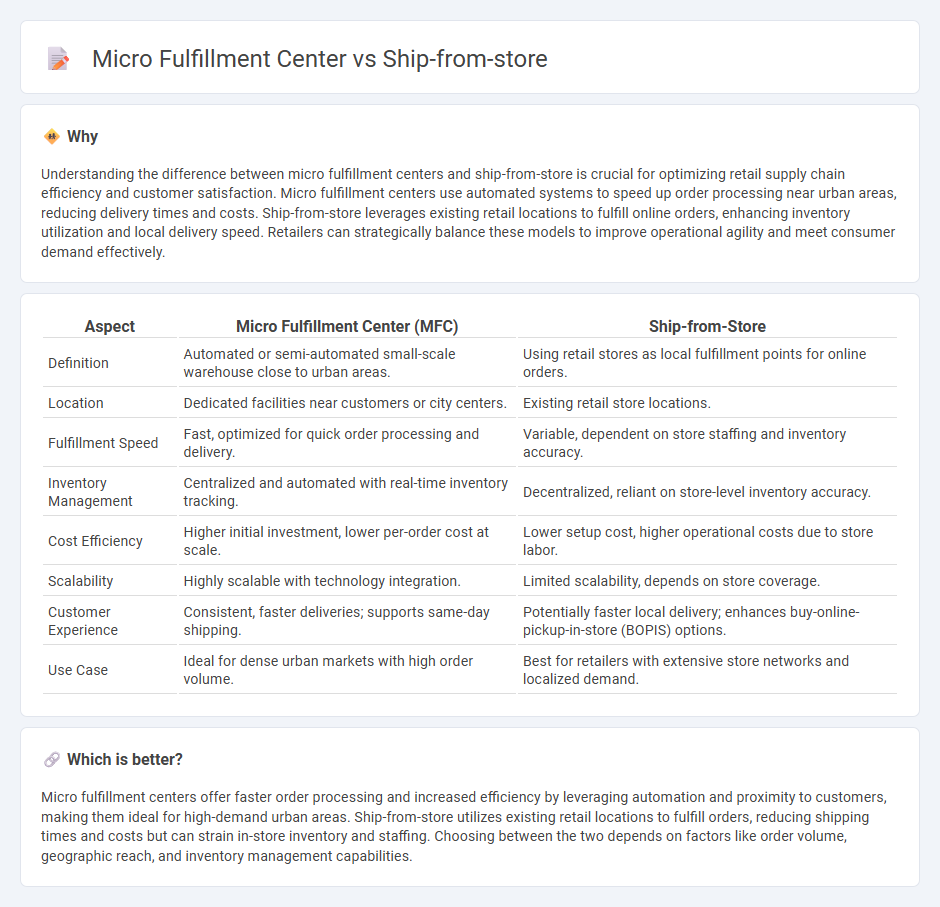
Micro fulfillment centers enhance retail efficiency by enabling rapid order processing through automated, small-scale warehouses located near urban areas. Ship-from-store leverages existing retail locations to fulfill online orders, reducing shipping times and inventory costs. Explore the benefits and challenges of each model to optimize your retail fulfillment strategy.
Why it is important
Understanding the difference between micro fulfillment centers and ship-from-store is crucial for optimizing retail supply chain efficiency and customer satisfaction. Micro fulfillment centers use automated systems to speed up order processing near urban areas, reducing delivery times and costs. Ship-from-store leverages existing retail locations to fulfill online orders, enhancing inventory utilization and local delivery speed. Retailers can strategically balance these models to improve operational agility and meet consumer demand effectively.
Comparison Table
| Aspect | Micro Fulfillment Center (MFC) | Ship-from-Store |
|---|---|---|
| Definition | Automated or semi-automated small-scale warehouse close to urban areas. | Using retail stores as local fulfillment points for online orders. |
| Location | Dedicated facilities near customers or city centers. | Existing retail store locations. |
| Fulfillment Speed | Fast, optimized for quick order processing and delivery. | Variable, dependent on store staffing and inventory accuracy. |
| Inventory Management | Centralized and automated with real-time inventory tracking. | Decentralized, reliant on store-level inventory accuracy. |
| Cost Efficiency | Higher initial investment, lower per-order cost at scale. | Lower setup cost, higher operational costs due to store labor. |
| Scalability | Highly scalable with technology integration. | Limited scalability, depends on store coverage. |
| Customer Experience | Consistent, faster deliveries; supports same-day shipping. | Potentially faster local delivery; enhances buy-online-pickup-in-store (BOPIS) options. |
| Use Case | Ideal for dense urban markets with high order volume. | Best for retailers with extensive store networks and localized demand. |
Which is better?
Micro fulfillment centers offer faster order processing and increased efficiency by leveraging automation and proximity to customers, making them ideal for high-demand urban areas. Ship-from-store utilizes existing retail locations to fulfill orders, reducing shipping times and costs but can strain in-store inventory and staffing. Choosing between the two depends on factors like order volume, geographic reach, and inventory management capabilities.
Connection
Micro fulfillment centers enhance the retail supply chain by enabling faster order processing and local inventory management, which directly supports effective ship-from-store operations. Retailers utilize micro fulfillment centers to stock high-demand items near urban areas, facilitating quicker shipping times when orders are fulfilled from store locations. This integration reduces delivery costs, improves customer satisfaction, and optimizes inventory distribution across retail networks.
Key Terms
Inventory Management
Ship-from-store leverages existing retail locations to fulfill online orders, enabling real-time inventory visibility and reducing delivery times through localized stock management. Micro fulfillment centers concentrate inventory in compact, automated warehouses near urban areas, optimizing stock organization and enhancing order accuracy while lowering transportation costs. Explore how integrating these models can transform your inventory management strategy for improved efficiency and customer satisfaction.
Order Fulfillment Speed
Ship-from-store leverages existing retail locations to fulfill orders quickly by reducing last-mile delivery times, ideal for urban areas with dense store networks. Micro fulfillment centers, equipped with automated systems and closer to consumers than traditional warehouses, offer faster picking and packing processes, accelerating order fulfillment speed significantly. Explore how these strategies can optimize your supply chain and boost customer satisfaction.
Last-Mile Delivery
Ship-from-store leverages existing retail locations to expedite last-mile delivery by utilizing in-store inventory, reducing delivery times and ramping up customer satisfaction. Micro fulfillment centers are strategically located small warehouses equipped with automated technology to optimize order picking and packing, enhancing delivery efficiency and accuracy. Explore the latest trends in last-mile delivery solutions to determine which strategy best suits your business needs.
Source and External Links
Ship From Store: Definition, Operation & Key Benefits - OneStock - Ship From Store is an omnichannel solution where physical retail stores act as mini-warehouses, shipping online orders directly, managed by an Order Management System that optimizes stock allocation to reduce delivery time and costs.
Ship from Store: Transforming Retail Fulfillment - Ship From Store uses physical stores as fulfillment hubs to ship online orders directly to customers from the nearest store with stock, improving delivery speed and costs while enhancing omnichannel retail experience.
What Is Ship From Store? Create Your Strategy (2025) - Shopify - Ship From Store is a fulfillment method where retailers fulfill online orders from their brick-and-mortar stores rather than central warehouses, allowing faster delivery (1-2 days) and seamless omnichannel sales integration.
 dowidth.com
dowidth.com